Key takeaways:
- Neo-Classicism, emerging in the mid-18th century, aimed to revive the ideals of ancient Greece and Rome, emphasizing harmony, simplicity, and intellectual depth.
- Key artists like Jacques-Louis David, Jean-Auguste-Dominique Ingres, and Antonio Canova exemplified the movement’s principles through their powerful depiction of moral narratives and emotional complexity.
- Notable artworks such as “The Oath of the Horatii,” “La Grande Odalisque,” and “Psyche Revived by Cupid’s Kiss” illustrate the genre’s themes of virtue, beauty, and the interplay of idealism and reality.
- Engaging with Neo-Classical art in galleries offers a unique, immersive experience that deepens appreciation for the artists’ intent and the timeless relevance of their themes in contemporary society.
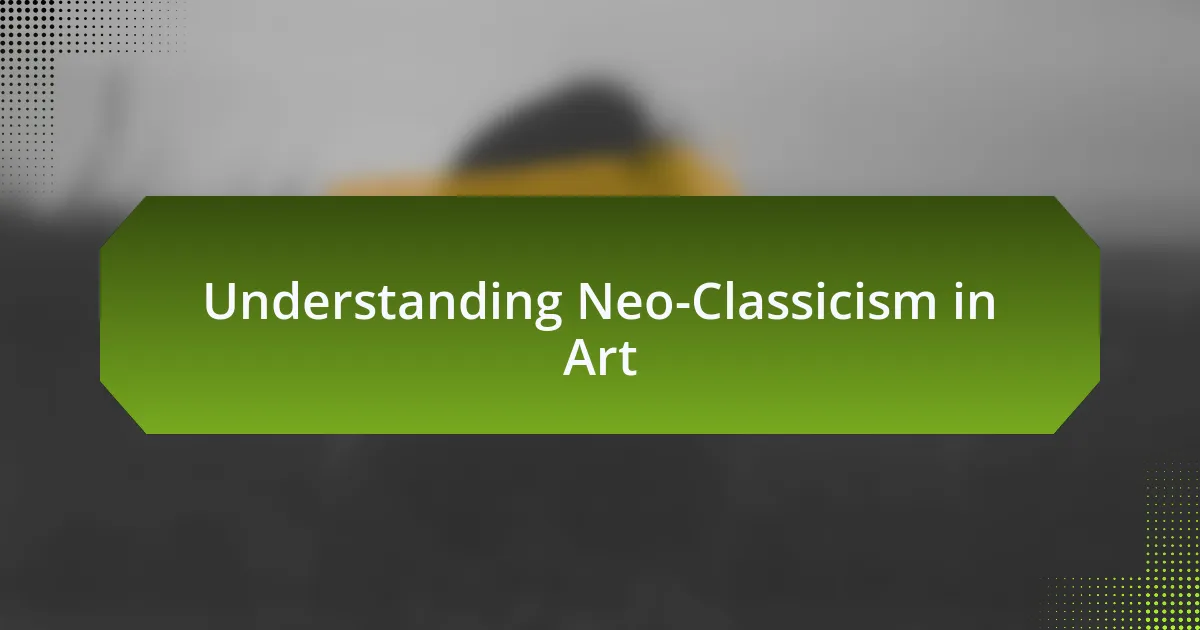
Understanding Neo-Classicism in Art
Neo-Classicism emerged in the mid-18th century as a reaction against the exuberance of the Baroque and Rococo styles. This movement sought to revive the classical ideals of ancient Greece and Rome, emphasizing harmony, simplicity, and proportion. I remember visiting a gallery and standing before Jacques-Louis David’s “Oath of the Horatii.” The stark lines and dramatic composition left me pondering how such artworks could convey moral virtue and civic duty so powerfully.
As I delved deeper into Neo-Classicism, I felt an undeniable connection to its underlying philosophy. The artists of this era were not just creators; they were also intellectuals and historians, channeling the values of stoicism and rationality. Have you ever noticed how a well-structured artwork can evoke a sense of calm and order? This was the essence of Neo-Classicism — creating a visual language that communicated both beauty and intellect.
One fascinating aspect of Neo-Classicism is its ability to grapple with contemporary societal issues while drawing from the past. When I encountered Jean-Auguste-Dominique Ingres’s “Grand Odalisque,” it sparked a debate within me: how do we balance idealism with reality? The tension between fantasy and authenticity in this work led me to appreciate the deeper commentary that Neo-Classical artists often embedded within their pieces, inviting viewers to reflect on their own values and beliefs.
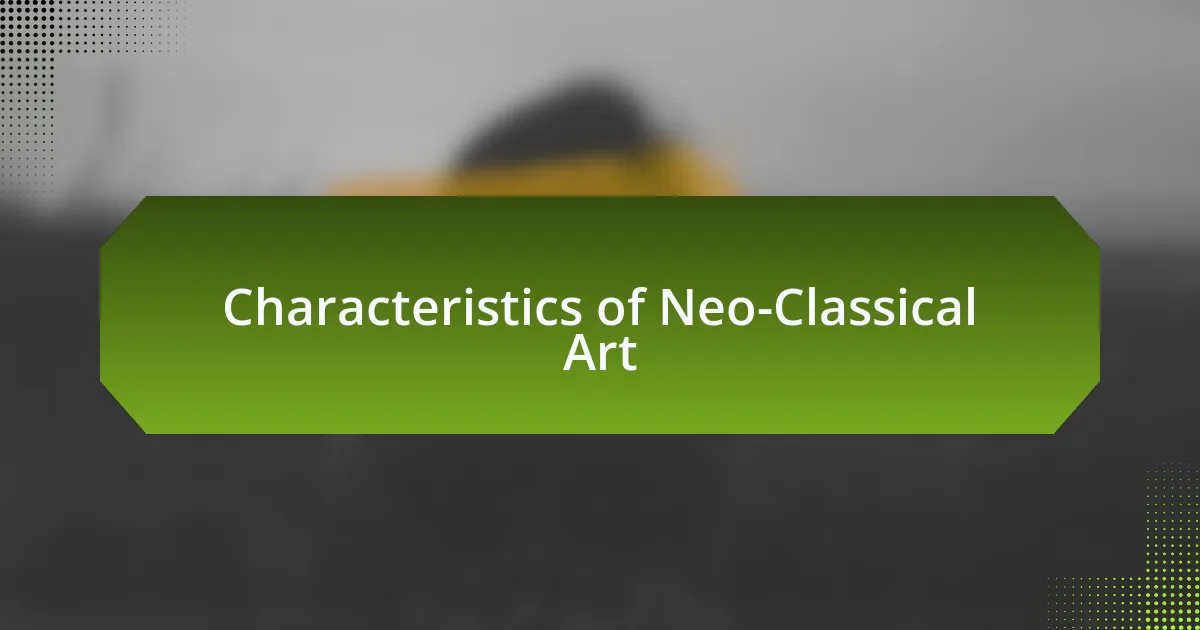
Characteristics of Neo-Classical Art
The characteristics of Neo-Classical art are deeply rooted in the principles of clarity and simplicity. When I first encountered the works of Antonio Canova, such as his sculpture “Psyche Revived by Cupid’s Kiss,” I was struck by the smooth finishes and precise outlines that create an almost ethereal quality. It made me reflect on how effective the aesthetic choices in Neo-Classicism are in conveying emotion through restraint rather than excess.
Another hallmark of this style is the emphasis on historical and mythological themes. I recall standing in awe before Jacques-Louis David’s “Death of Socrates,” where the dramatic depiction of virtuous sacrifice was not only striking but also a powerful narrative about moral conviction. This piece exemplifies how Neo-Classical artists drew inspiration from ancient stories to address contemporary moral dilemmas, making me question: how can the tales of the past still resonate in today’s world?
Lastly, the adherence to balanced composition in Neo-Classical artworks often leads to a sense of harmony that I find incredibly appealing. For instance, I remember studying “The Death of Sardanapalus,” also by David, and noticing how every element appeared carefully arranged to create both tension and resolution. It left me wondering how such precision could evoke such strong emotions, highlighting that, in Neo-Classical art, every line and color is a deliberate choice aimed at conveying profound meaning.
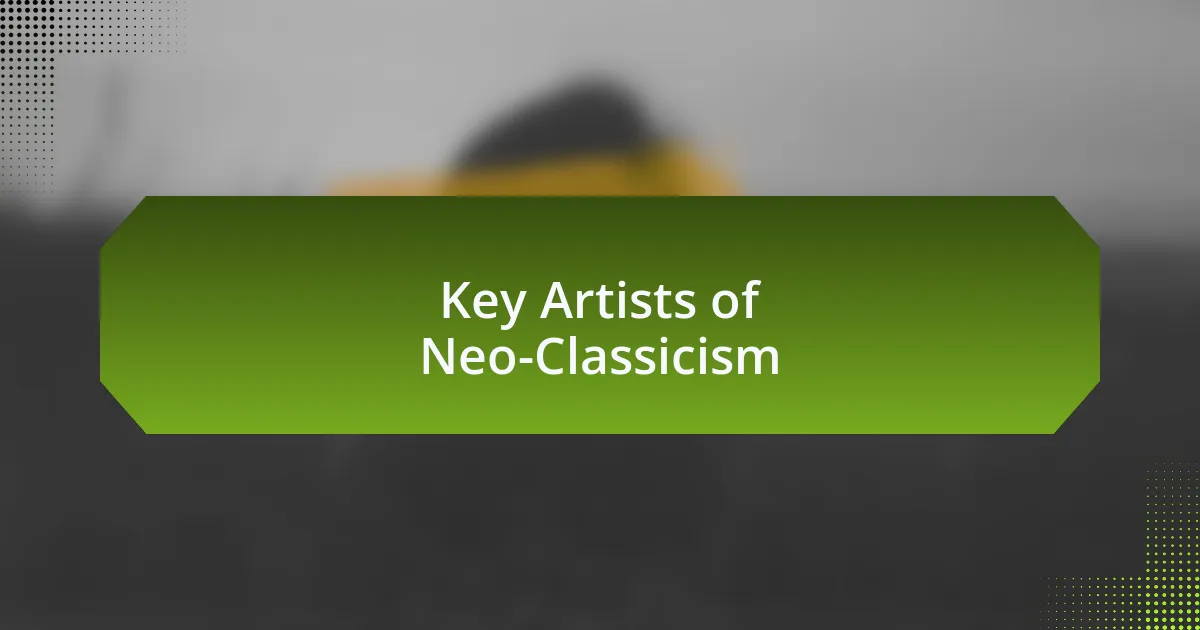
Key Artists of Neo-Classicism
When I think of key artists in Neo-Classicism, I can’t help but admire Jean-Auguste-Dominique Ingres. His painting “La Grande Odalisque” showcases a blend of ideal beauty and exoticism, compelling me to consider how he reinterpreted classical forms to suit both artistic and cultural contexts. I remember being intrigued by the way he elongated the female body, which sparked discussions in my mind about the fine line between idealism and reality in representation.
Another prominent figure is Antonio Canova, whose sculptural works resonate with a timeless grace. Walking through a gallery of his sculptures, I felt a profound connection to the themes of love and loss. His piece “Venus Victrix” perfectly embodies the delicate interplay between strength and vulnerability, prompting me to ask: how does one capture such complex emotions in stone?
Finally, Jacques-Louis David’s influence cannot be overlooked. His intense focus on historical narratives, particularly in works like “The Oath of the Horatii,” left me contemplating the role of patriotism in art. David’s ability to convey drama and emotion through controlled gestures and expressions made me realize how powerful storytelling can be when infused with artistic techniques. Would it be possible for modern artists to evoke similar sentiments today?
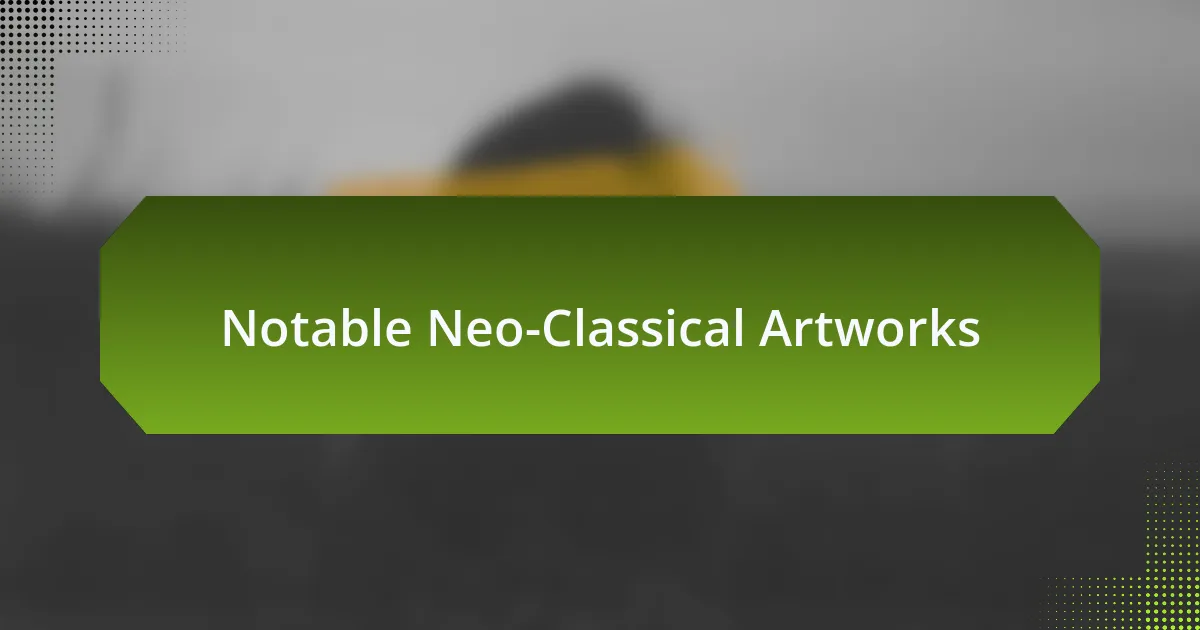
Notable Neo-Classical Artworks
When discussing notable Neo-Classical artworks, one cannot overlook the impact of Jean-Auguste-Dominique Ingres’ “La Grande Odalisque.” I vividly recall the first time I stood before this painting. The tension between its idealized forms and the raw sensuality made me consider how artists navigate depicting the human experience amidst rigid artistic conventions. It begs the question: what do we sacrifice in our quest for the perfect representation?
Another work that captivates my attention is Antonio Canova’s “Psyche Revived by Cupid’s Kiss.” I remember being struck by the intricate details of the figures’ expressions, which told a story of longing and tenderness. It fascinated me how Canova turned marble into a soft, almost palpable emotion, inviting the viewer into a moment that feels both immediate and timeless. This made me reflect on the unique ability of sculptures to convey deep narratives without uttering a single word.
Then there’s Jacques-Louis David’s “The Death of Socrates,” which I encountered during a visiting exhibit. The way David captures Socrates’ defiance in the face of death illuminated the tension between personal conviction and societal pressure for me. It sparked a dialogue in my mind about the influence of historical context on artistic expression—how can we, as modern viewers, still relate to such passionate convictions demonstrated through art?
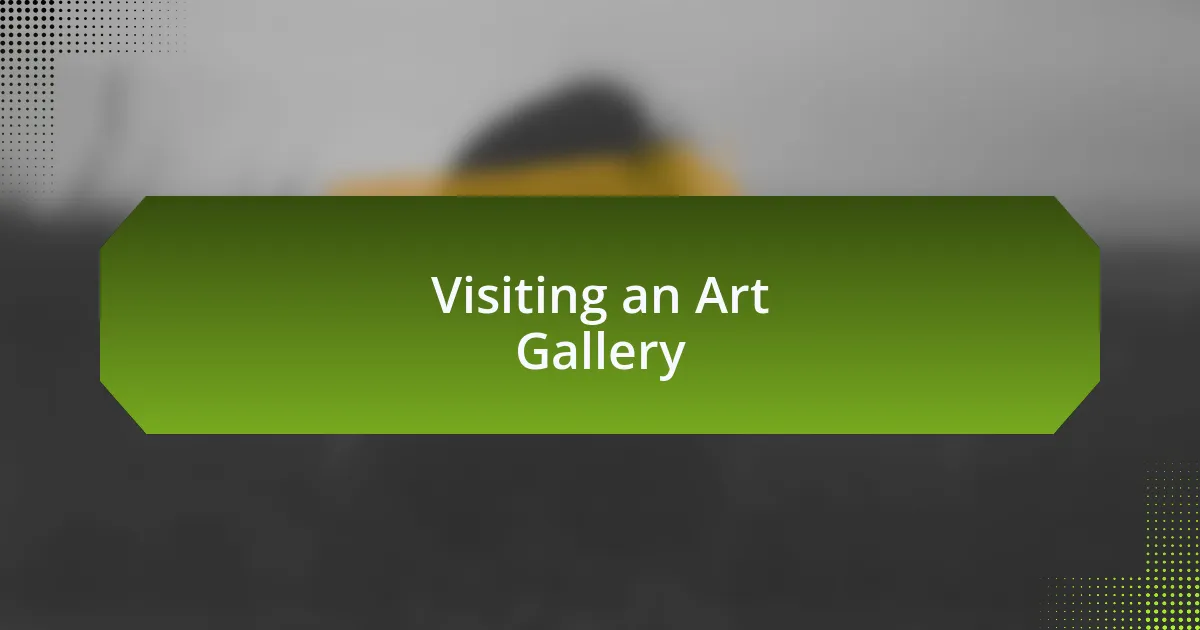
Visiting an Art Gallery
Stepping into an art gallery is like entering a different world, where time seems to stand still. I remember my first visit to a grand gallery; the sheer size of the space was almost overwhelming. Each painting and sculpture invited me to pause and reflect, making me wonder how many stories were woven into the fabric of those artworks.
As I walked through the silent halls, I found myself lost in thought. The play of light on the canvases reminded me how essential lighting is to experiencing art. It prompted me to think: does the atmosphere created within a gallery change our perception of the piece? I’ve often noticed that a piece can feel entirely different depending on the time of day or even my mood during the visit.
Engaging with art in person presents an intimacy that photographs simply can’t replicate. I recall standing inches away from a striking portrait, the brushstrokes almost palpable. It made me question—how does proximity affect our connection to the artwork? This tactile experience sparked a deeper appreciation for the artist’s intent, reminding me of the emotional resonance found in viewing art up close.
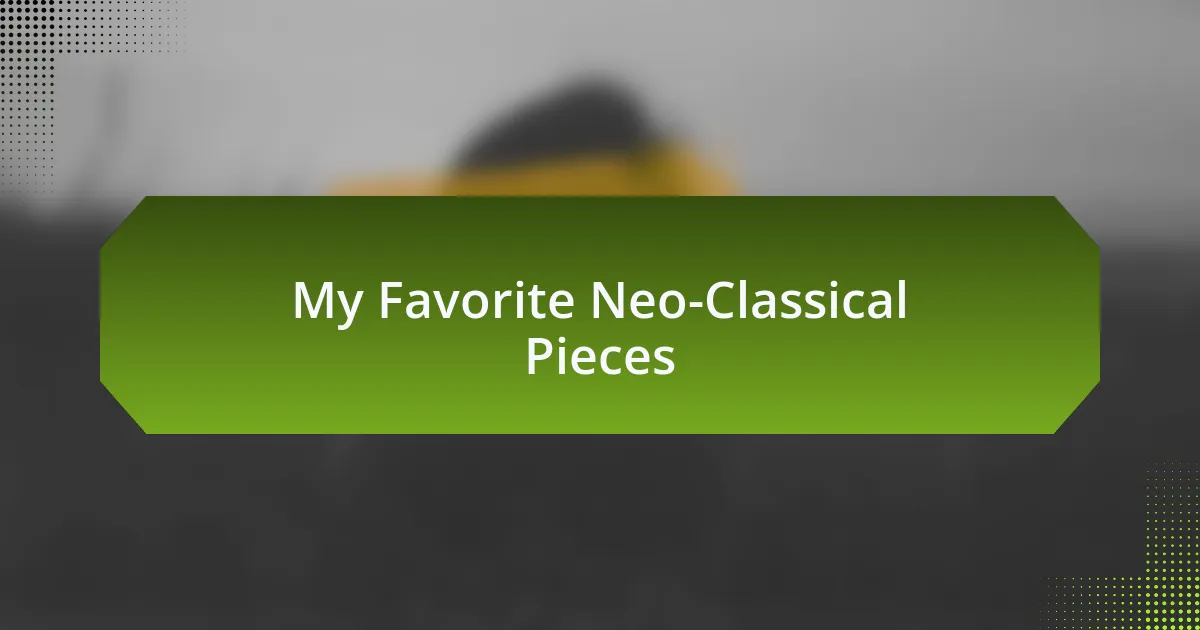
My Favorite Neo-Classical Pieces
When I first encountered Jean-Auguste-Dominique Ingres’ “The Grand Odalisque,” I was taken aback by its exquisite detail and sensuality. The way Ingres portrayed the figure of the odalisque with elongated proportions felt both captivating and challenging; it ignited a thought in me—how does the artist’s interpretation shape our understanding of beauty? I could almost feel the languid atmosphere of the scene enveloping me, and I left the gallery with a sense of yearning to explore more about Neo-Classical ideals.
Another piece that deeply resonates with me is Antonio Canova’s sculpture “Psyche Revived by Cupid’s Kiss.” Standing before it, I felt a rush of emotion as I pondered the narrative frozen in marble. It’s fascinating how Canova captured such tenderness and longing, sparking a reflection on love’s power. I often find myself wondering: what stories does this sculpture whisper to those who view it?
Lastly, I can’t overlook Jacques-Louis David’s “Oath of the Horatii,” a dramatic testament to patriotism and sacrifice. The stark contrasts of light and shadow emphasize the tension within the scene, which prompts viewers, including myself, to question their own values. How do we respond to themes of loyalty and duty in our lives today? This piece has left an indelible mark on my understanding of art’s capability to provoke thought and inspire a deeper exploration of personal and communal ideals.
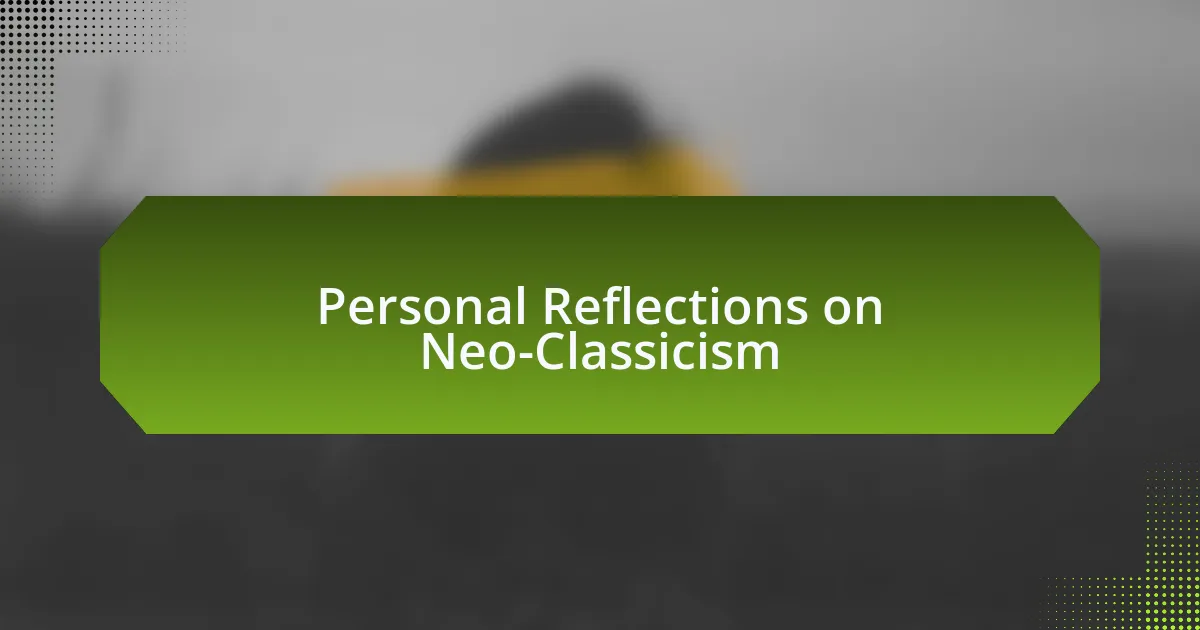
Personal Reflections on Neo-Classicism
Standing in front of David’s “Oath of the Horatii” for the first time was truly a transformative moment for me. I remember feeling a surge of pride mixed with solemnity as I absorbed the figures’ resolve. How often does art compel us to evaluate our own commitments to the greater good? This piece exemplifies Neo-Classicism’s ability to evoke profound emotions and stimulate introspection.
I often reflect on how Neo-Classicism challenges our contemporary views. The principles of order and harmony in these works resonate with me, especially in today’s chaotic world. Can we find solace in the structured beauty of art? It seems that if we engage with these principles, we might cultivate a sense of tranquility in our own lives.
Visiting art galleries that showcase Neo-Classical pieces has become a cherished ritual for me. Each visit opens my eyes to the intricate narratives behind the art, making me ponder the relevance of these ideals in modern times. What if we embraced the values of virtue and simplicity that inspired these artists? My journeys into this artistic movement are a reminder that we can draw strength from the past as we navigate our present.